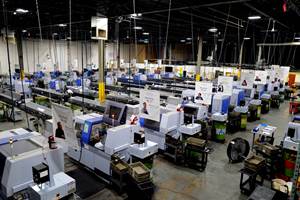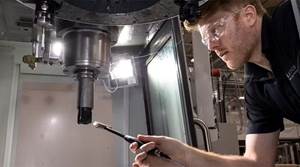Tips for Controlling Oxidation and Pitting on a Wire EDM
Additives, machine settings, workpiece materials and current technology are factors in avoiding common problems with unwanted rust and surface defects.
Share





Additives:
Additives do help in controlling oxidation and pitting of a variety of materials. These products help a great deal when cutting a workpiece with pre-polished surfaces.
Set the water conductivity to 5 microS or less, which is typically recommended for carbide, PCD, titanium, and fine finishes (<10 micro inches). This will also help keep bluing to a minimum on older non-anti-electrolysis generators.
Check water pH. Acidic detergents used to clean parts and tank will have a dramatic effect on parts rusting and will reduce the life of the deionization bottles.
Mix Workpiece Materials
With all the new and old types of alloys available, material incompatibility may cause surface issues. However, EDM field technicians have yet to document an instance where this situation has occurred.
New Machines
Most current wire EDMs are equipped with Anti-Electrolysis generators, some better then others. It basically comes down to how good the technology is and how fine of a surface finish the generator is capable of producing. A machine that is capable of producing a super fine finish (< 5 micro inches) can generate optimum surface integrity.
One example is the GF AgieCharmilles CUT 1000 that can machine parts with zero corrosion. The CUT 1000 is available in an oil version. With this feature, there is absolutely no electrolysis, corrosion and virtually zero recast.
Related Content
The Future of High Feed Milling in Modern Manufacturing
Achieve higher metal removal rates and enhanced predictability with ISCAR’s advanced high-feed milling tools — optimized for today’s competitive global market.
Read MoreInside the Premium Machine Shop Making Fasteners
AMPG can’t help but take risks — its management doesn’t know how to run machines. But these risks have enabled it to become a runaway success in its market.
Read MoreHow to Mitigate Chatter to Boost Machining Rates
There are usually better solutions to chatter than just reducing the feed rate. Through vibration analysis, the chatter problem can be solved, enabling much higher metal removal rates, better quality and longer tool life.
Read MoreInside a CNC-Machined Gothic Monastery in Wyoming
An inside look into the Carmelite Monks of Wyoming, who are combining centuries-old Gothic architectural principles with modern CNC machining to build a monastery in the mountains of Wyoming.
Read MoreRead Next
Machine Shop MBA
Making Chips and Modern Machine Shop are teaming up for a new podcast series called Machine Shop MBA—designed to help manufacturers measure their success against the industry’s best. Through the lens of the Top Shops benchmarking program, the series explores the KPIs that set high-performing shops apart, from machine utilization and first-pass yield to employee engagement and revenue per employee.
Read MoreAMRs Are Moving Into Manufacturing: 4 Considerations for Implementation
AMRs can provide a flexible, easy-to-use automation platform so long as manufacturers choose a suitable task and prepare their facilities.
Read More

















